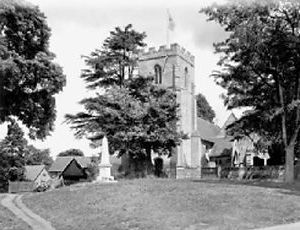History of Whitnash
History of Whitnash
A school for the
poor of Whitnash
Built in 1861, it was partially endowed by
Henry Eyres Landor Esquire.
The free school was built for the
poor inhabitants of Whitnash,
and the purpose was to teach
the children to work in agriculture
or other forms of labour.
It catered for children between
the ages of 5 to 14 years,
and their studies were five days a week
9am until 4pm with a break at midday
for one hour.
A school for the poor of Whitnash
Built in 1861, it was partially endowed by Henry Eyres Landor Esquire.
The free school was built for the poor inhabitants of Whitnash, and the purpose
was to teach the children to work in agriculture or other forms of labour.
It catered for children between the ages of 5 to 14 years, and their studies
were five days a week 9am until 4pm with a break at midday for one hour.
A school for the poor of Whitnash
Built in 1861, it was partially endowed by Henry Eyres Landor Esquire.
The free school was built for the poor inhabitants of Whitnash, and the purpose was to teach the children to work in agriculture or other forms of labour.
It catered for children between the ages of 5 to 14 years, and their studies were five days a week 9am until 4pm with a break at midday for one hour.

Hover over the 3 Ash tree images to see the colour version.
Whitnash was mentioned
in the Doomsday Book as Witenas,
by 1326 it had become
Whitenasshe meaning 'white ash'.
As Whitnash is generally thought
to derive from the Anglo-Saxon
‘at the white ash’
other derivations have included
‘place by the wood’,
‘sacred ash’
or the
'meeting place of the wise'.
Whitnash has likely been settled
since Celtic times.
According to tradition, just east of the town
there was a Celtic fortification in a field
known as “Castle Hill Field”.
The parish church of St Margaret's
is of Anglo-Saxon origin,
and stands on a mound which may have been
a pre-Christian pagan site,
it was largely rebuilt between 1855 and 1880.
Whitnash at one time had a holy well,
located around 400 metres east of the town.
According to a local legend, a church bell was dropped accidentally into the well when it was being taken there to be consecrated,
according to the legend, the bell then gained
the ability to foretell the future;
at night time people would drop a stone
into the well and ask a question.
Then at daybreak it would give its answer:
one ring for yes and two for no.
The bell is commemorated in
Whitnash's municipal crest.
Whitnash was for most of its history
a small village, the population in 1931 was 586.
Around the historic core of the old village
are a number of old half timbered buildings
dating from the 17th century,
including the Plough and Harrow inn.
Until modern times, Whitnash was
a fairly isolated community,
which has led to it retaining a
strong sense of local identity.
Dramatic population growth began
during the second half of the 20th century.
Reflecting its much larger size,
in 1978 Whitnash became a town
through the resolution of its parish council; thenceforth the parish council
became a town council.
Whitnash was mentioned in the Doomsday Book as Witenas,
by 1326 it had become Whitenasshe meaning 'white ash'.
As Whitnash is generally thought to derive from the Anglo-Saxon ‘at the white ash’
other derivations have included ‘place by the wood’, ‘sacred ash’ or the 'meeting place of the wise'.
Whitnash has likely been settled since Celtic times.
According to tradition, just east of the town there was a Celtic fortification
in a field known as “Castle Hill Field”.
The parish church of St Margaret's is of Anglo-Saxon origin,
and stands on a mound which may have been a pre-Christian pagan site,
it was largely rebuilt between 1855 and 1880.
Whitnash at one time had a holy well, located around 400 metres east of the town.
According to a local legend, a church bell was dropped accidentally into the well
when it was being taken there to be consecrated,
according to the legend, the bell then gained the ability to foretell the future;
at night time people would drop a stone into the well and ask a question.
Then at daybreak it would give its answer: one ring for yes and two for no.
The bell is commemorated in Whitnash's municipal crest.
Whitnash was for most of its history a small village, the population in 1931 was 586.
Around the historic core of the old village are a number of old half timbered buildings
dating from the 17th century, including the Plough and Harrow inn.
Until modern times, Whitnash was a fairly isolated community,
which has led to it retaining a strong sense of local identity.
Dramatic population growth began during the second half of the 20th century.
Reflecting its much larger size, in 1978 Whitnash became a town
through the resolution of its parish council; thenceforth the parish council became a town council.
Whitnash was mentioned in the Doomsday Book as Witenas, by 1326 it had become Whitenasshe meaning 'white ash'.
As Whitnash is generally thought to derive from the Anglo-Saxon ‘at the white ash’ other derivations have included ‘place by the wood’, ‘sacred ash’ or the 'meeting place of the wise'.
Whitnash has likely been settled since Celtic times. According to tradition, just east of the town there was a Celtic fortification in a field known as “Castle Hill Field”.
The parish church of St Margaret's is of Anglo-Saxon origin, and stands on a mound which may have been a pre-Christian pagan site, it was largely rebuilt between 1855 and 1880.
Whitnash at one time had a holy well, located around 400 metres east of the town.
According to a local legend, a church bell was dropped accidentally into the well when it was being taken there to be consecrated,
according to the legend, the bell then gained the ability to foretell the future; at night time people would drop a stone into the well and ask a question.
Then at daybreak it would give its answer: one ring for yes and two for no. The bell is commemorated in Whitnash's municipal crest.
Whitnash was for most of its history a small village, the population in 1931 was 586.
Around the historic core of the old village are a number of old half timbered buildings dating from the 17th century, including the Plough and Harrow inn.
Until modern times, Whitnash was a fairly isolated community, which has led to it retaining a strong sense of local identity.
Dramatic population growth began during the second half of the 20th century.
Reflecting its much larger size, in 1978 Whitnash became a town through the resolution of its parish council; thenceforth the parish council became a town council.
Page last updated 180825








